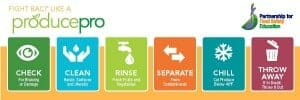Displays and radio messages provide customers with food safety info to take home with purchases.
The Partnership for Food Safety Education worked with contributing partner Kroger to create a week- by- week Food Safety Education Month outreach plan. We thank every participating Kroger Co. store for connecting with customers on this important topic!
With the help of their local Kroger stores, thousands of Michigan consumers took steps in September toward becoming ProducePros.
The Partnership’s ProducePro campaign is six actionable practices for consumers to enjoy fresh and safe fruits and vegetables at home. Kroger used campaign elements to create stanchion signs for set-up in all 124 Michigan Kroger stores. The stores also used in-store radio to broadcast consumer food safety tips read by a Kroger chef. What a great way to inform consumers during the shopping experience!
Some stores decided to do more, setting up food safety tables where customers could get the Partnership’s Franken BAC Drawing Contest page and free Home Food Safety Mythbusters flyers.
Thank you Michigan Kroger!
